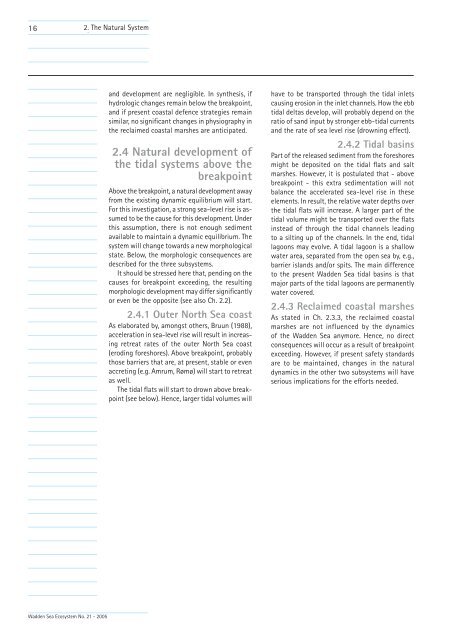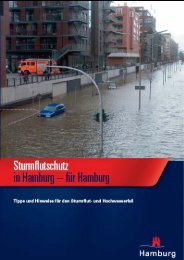Coastal Protection and Sea Level Rise - Hochwasser
Coastal Protection and Sea Level Rise - Hochwasser
Coastal Protection and Sea Level Rise - Hochwasser
Create successful ePaper yourself
Turn your PDF publications into a flip-book with our unique Google optimized e-Paper software.
16<br />
3. Integrated 2. The Natural BEP Solutions System<br />
<strong>and</strong> development are negligible. In synthesis, if<br />
hydrologic changes remain below the breakpoint,<br />
<strong>and</strong> if present coastal defence strategies remain<br />
similar, no significant changes in physiography in<br />
the reclaimed coastal marshes are anticipated.<br />
2.4 Natural development of<br />
the tidal systems above the<br />
breakpoint<br />
Above the breakpoint, a natural development away<br />
from the existing dynamic equilibrium will start.<br />
For this investigation, a strong sea-level rise is assumed<br />
to be the cause for this development. Under<br />
this assumption, there is not enough sediment<br />
available to maintain a dynamic equilibrium. The<br />
system will change towards a new morphological<br />
state. Below, the morphologic consequences are<br />
described for the three subsystems.<br />
It should be stressed here that, pending on the<br />
causes for breakpoint exceeding, the resulting<br />
morphologic development may differ significantly<br />
or even be the opposite (see also Ch. 2.2).<br />
2.4.1 Outer North <strong>Sea</strong> coast<br />
As elaborated by, amongst others, Bruun (1988),<br />
acceleration in sea-level rise will result in increasing<br />
retreat rates of the outer North <strong>Sea</strong> coast<br />
(eroding foreshores). Above breakpoint, probably<br />
those barriers that are, at present, stable or even<br />
accreting (e.g. Amrum, Rømø) will start to retreat<br />
as well.<br />
The tidal flats will start to drown above breakpoint<br />
(see below). Hence, larger tidal volumes will<br />
have to be transported through the tidal inlets<br />
causing erosion in the inlet channels. How the ebb<br />
tidal deltas develop, will probably depend on the<br />
ratio of s<strong>and</strong> input by stronger ebb-tidal currents<br />
<strong>and</strong> the rate of sea level rise (drowning effect).<br />
2.4.2 Tidal basins<br />
Part of the released sediment from the foreshores<br />
might be deposited on the tidal flats <strong>and</strong> salt<br />
marshes. However, it is postulated that - above<br />
breakpoint - this extra sedimentation will not<br />
balance the accelerated sea-level rise in these<br />
elements. In result, the relative water depths over<br />
the tidal flats will increase. A larger part of the<br />
tidal volume might be transported over the flats<br />
instead of through the tidal channels leading<br />
to a silting up of the channels. In the end, tidal<br />
lagoons may evolve. A tidal lagoon is a shallow<br />
water area, separated from the open sea by, e.g.,<br />
barrier isl<strong>and</strong>s <strong>and</strong>/or spits. The main difference<br />
to the present Wadden <strong>Sea</strong> tidal basins is that<br />
major parts of the tidal lagoons are permanently<br />
water covered.<br />
2.4.3 Reclaimed coastal marshes<br />
As stated in Ch. 2.3.3, the reclaimed coastal<br />
marshes are not influenced by the dynamics<br />
of the Wadden <strong>Sea</strong> anymore. Hence, no direct<br />
consequences will occur as a result of breakpoint<br />
exceeding. However, if present safety st<strong>and</strong>ards<br />
are to be maintained, changes in the natural<br />
dynamics in the other two subsystems will have<br />
serious implications for the efforts needed.<br />
Wadden <strong>Sea</strong> Ecosystem No. 21 - 2005




